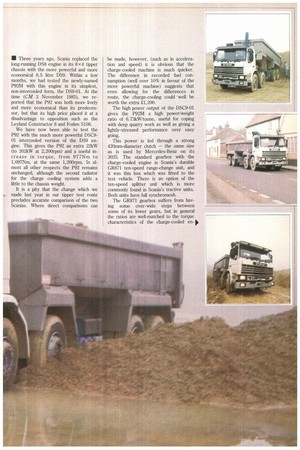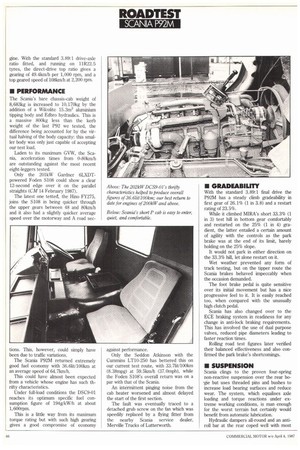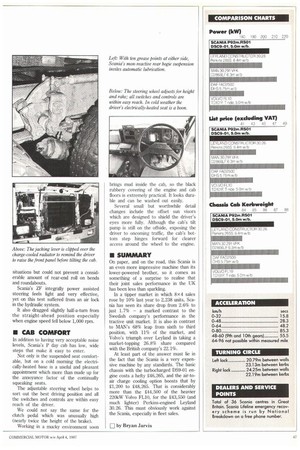AN EXPENSIV ECONOMY
Page 46

Page 47

Page 48

Page 49

If you've noticed an error in this article please click here to report it so we can fix it.
Scania's P92M 8x4 tipper, when fitted with the optional DSC9-01 charge cooled engine, offers improved power and economy, but at a price that may hamper its market penetration. • Three years ago, Scania replaced the long-running DS8 engine in its 8x4 tipper chassis with the more powerful and more economical 8.5 litre DS9. Within a few months, we had tested the newly-named P92M with this engine in its simplest, non-intercooled form, the DS9-01. At the time (CM 2 November 1985), we reported that the P92 was both more lively and more economical than its predecessor, but that its high price placed it at a disadvantage to opposition such as the Leyland Constructor 8 and Foden S108.
We have now been able to test the P92 with the much more powerful DSC901 intercooled version of the DS9 engine. This gives the P92 an extra 22kW (to 202kW at 2,200rpm) and a useful increase in torque, from 977Nm to 1,097Nni, at the same 1,200rpm. In almost all other respects the P92 remains unchanged, although the second radiator for the charge cooling system adds a little to the chassis weight.
It is a pity that the change which we made last year in our tipper test route precludes accurate comparison of the two Scanias. Where direct comparisons can be made, however, (such as in acceleration and speed) it is obvious that the charge-cooled machine is much quicker. The difference in recorded fuel consumption (well over 10% in favour of the more powerful machine) suggests that even allowing for the differences in route, the charge-cooling could well be worth the extra £1,200.
The high power output of the DSC9-01 Oyes the P92M a high power/weight ratio of 6.73kW/tonne, useful for coping with deep quarry work as well as giving a lightly-stressed performance over easy going.
This power is fed through a strong 420mm-diameter clutch — the same size as is used by Mercedes-Benz on its 3025. The standard gearbox with the charge-cooled engine is Scania's durable GR871 ten-speed range-change unit, and it was this box which was fitted to the test vehicle. There is an option of the ten-speed splitter unit which is more commonly found in Scania's tractive units. Both units have full synchromesh.
The GR871 gearbox suffers from having some over-wide steps between some of its lower gears, but in general the ratios Are well-matched to the torque characteristics of the charge-cooled en
With the standard 3.89:1 drive-aide ratio fitted, and running on 11R22.5 tyres, the direct-drive top ratio gives a gearing of 49.4km/b per 1,000 rpm, and a top geared speed of 108km/h at 2,200 rpm.
• PERFORMANCE
The Scania's bare chassis-cab weight of 8,683kg is increased to 10,170kg by the addition of a Wilcolite 15.3m3 aluminium tipping body and Edbro hydraulics. This is a massive 800kg less than the kerb weight of the last P92 we tested, the difference being accounted for by the virtual halving of the body capacity: this smaller body was only just capable of accepting our test load.
Laden to its maximum GVW, the Scania, acceleration times from 0-80lan/h are outstanding against the most recent eight-leggers tested.
Only the 201kW Gardner 6LXDTpowered Foden 5108 could show a clear 12-second edge over it on the parallel straights (CM 14 February 1987).
The latest one tested, the Hino FY275, joins the S108 in being quicker through the upper gears between 48 and 80km/h and it also had a slightly quicker average speed over the motorway and A road sec tions. This, however, could simply have been due to traffic variations.
The Scania P92M returned extremely good fuel economy with 36.6lit/100km at an average speed of 64.7km/h.
This could have almost been expected from a vehicle whose engine has such thrifty characteristics.
Under full-load conditions the DSC9-01 reaches its optimum specific fuel consumption figure of 194g/kW/h at about 1,60Orpm.
This is a little way from its maximum torque rating but with such high gearing gives a good compromise of economy against performance.
Only the Seddon Atkinson with the Cummins LT10-250 has bettered this on our current test route, with 33. 7lit/100km (8.38mpg) at 59.5km/h (37.0mph), while the Foden SIO8's overall return was on a par with that of the Scania.
An intermittent pinging noise from the cab heater worsened and almost delayed the start of the first section.
The fault was eventually traced to a detached grub screw on the fan which was speedily replaced by a flying fitter from the nearby Scania service dealer, Merville Trucks of Lutterworth.
• GRADEABILITY
With the standard 3.89:1 final drive the P92M has a steady climb gradeability in first gear of 26.1% (1 in 3.8) and a restart rating of 23.5%.
While it climbed MIRA's short 33.3% (1 in 3) test hill in bottom gear comfortably and restarted on the 25% (1 in 4) gradient, the latter entailed a certain amount of agility with the controls as the park brake was at the end of its limit, barely holding on the 25% slope.
It would not park in either direction on the 33.3% hill, let alone restart on it.
Wet weather prevented any form of track testing, but on the tipper route the Scania brakes behaved impeccably when the occasion demanded.
The foot brake pedal is quite sensitive over its initial movement but has a nice progressive feel to it. It is easily reached too, when compared with the unusually high clutch pedal.
Scania has also changed over to the ECE braking system in readiness for any change in anti-lock braking requirements. This has involved the use of dual purpose valves, reduced pipe diameters leading to faster reaction times.
Rolling road test figures later verified their balanced effectiveness and also confirmed the park brake's shortcomings.
• SUSPENSION
Scania clings to the proven four-spring non-reactive suspension over the rear bogie but uses threaded pins and bushes to increase load bearing surfaces and reduce wear. The system, which equalises aide loading and torque reactions under extreme working conditions, is man enough for the worst terrain but certainly would benefit from automatic lubrication.
Hydraulic dampers all-round and an antiroll bar at the rear coped well with most situations but could not prevent a considerable amount of rear-end roll on bends and roundabouts.
Scania's ZF integrally power assisted steering feels light and very effective, yet on this test suffered from an air lock in the hydraulic system.
It also dragged slightly half-a-turn from the straight-ahead position especially when engine speed fell below 1,000 rpm.
II CAB COMFORT
In addition to having very acceptable noise levels, Scailla's P day cab has low, wide steps that make it easy to enter.
Not only is the suspended seat comfortable, but on a cold morning the electrically-heated base is a useful and pleasant appointment which more than made up for the annoyance factor of the continually squeaking seats.
The adjustable steering wheel helps to sort out the best driving position and all the switches and controls are within easy reach of the driver.
We could not say the same for the clutch pedal which was unusually high (nearly twice the height of the brake).
Working in a mucky environment soon brings mud inside the cab, so the black rubbery covering of the engine and cab floors is extremely practical. It looks durable and can be washed out easily.
Several small but worthwhile detail changes include the offset sun visors which are designed to shield the driver's eyes more fully. Although the cab's tilt pump is still on the offside, exposing the driver to oncoming traffic, the cab's bottom step hinges forward for clearer access around the wheel to the engine.
• SUMMARY
On paper, and on the road, this Scania is an even more impressive machine than its lower-powered brother, so it comes as something of a surprise to realise that their joint sales performance in the UK has been less than sparkling.
In a tipper market in which 8x4 sales rose by 10% last year to 2,238 units, Scania has seen its share drop from 2.6% to just 1.7% — a marked contrast to the Swedish company's performance in the tractive unit market. It is also in contrast to MAN's 68% leap from sixth to third position, with 11% of the market, and Volvo's triumph over Leyland in taking a market-topping 26.8% share compared with the British company's 22.1%.
At least part of the answer must lie in the fact that the Scania is a very expensive machine by any standards. The basic chassis with the turbocharged DS9-01 engine costs a hefty £46,265, and the air-toair charge cooling option boosts that by £1,200 to £48,265. That is considerably more than the £44,500 of the heavier 220kW Volvo FL10, for the £43,550 (and much lighter) Perkins-engined Leyland 30.26. This must obviously work against the Scania, especially in fleet sales.
by Bryan Jarvis




















































































